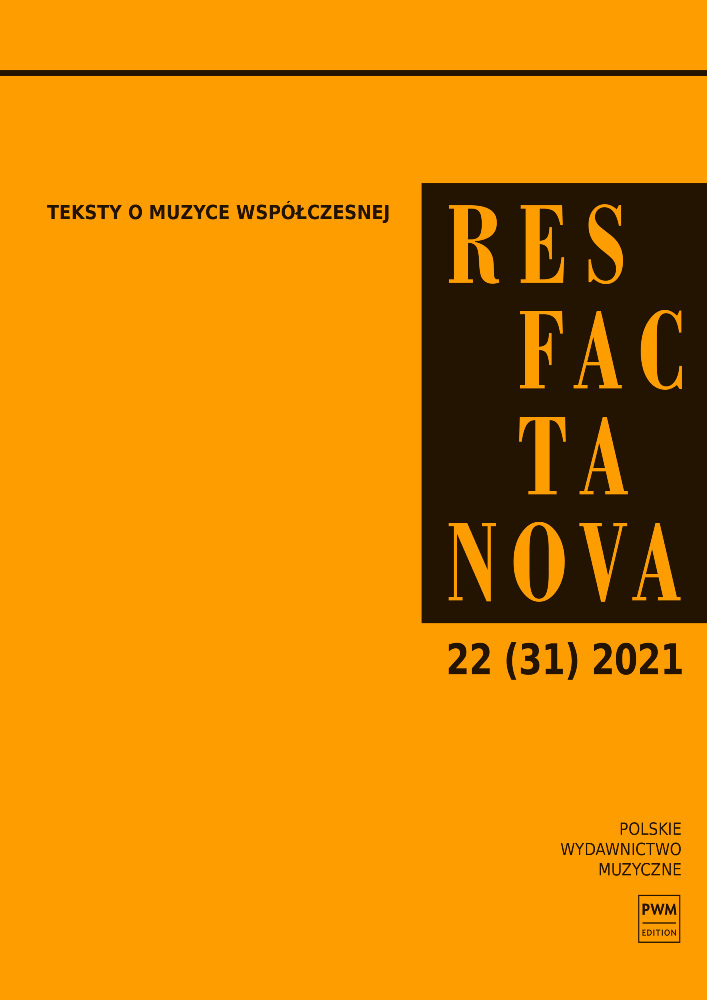Abstrakt
The study examines Ligeti’s “stylistic revolution” as well as the nonsense aspects of the composition and introduces an original analysis of Ligeti’s musical nonsense inspired by the literary analysis of nonsense by Susan Stewart.
The Nonsense Madrigals by György Ligeti take part in a kind of “stylistic revolution” in Ligeti’s style and are the result of his passionate research on African polyrhythms and its contribution to his music. What Ligeti intended to create in those periods was a superimposition of different rhythmic and melodic patterns in such a way that they could fuse together in an illusory chaos. However, there is also an ancient order that governs this new approach: the old masters such as Philippe de Vitry, Johannes Okeghem or Johannes Ciconia and their compositional techniques became the base of mixing the old western styles with the traditional music of Central Africa, so that the new and authentic compositional idea could blossom. The copious sketches of the Nonsense Madrigals, stored at the Paul Sacher Stiftung in Basel, reveal that the preparatory brainstorming involved also many other inspirations such as Balkan and oriental music, jazz, and some of Ligeti’s own compositions. The combination of the old and the new without using concrete models but just drawing inspiration marks a new approach among Ligeti’s contemporaries.
Bibliografia
Arom Simha, African polyphony and polyrhythm, Maison des Sciences de l'Homme, Cambridge University Press, Cambridge-New York-Paris 1991. https://doi.org/10.1017/CBO9780511518317 DOI: https://doi.org/10.1017/CBO9780511518317
Arom Simha, L'Aksak, "Cahiers de l'ethnomusicologie" [En ligne], 17/2004, mis en ligne le 13 janvier 2012. URL: http://ethnomusicologie.revues.org/413.
Arom Simha, Le ragioni della musica. Scritture di musicologia africanista, a cura di M. Agamennone e S. Facci, Libreria Musicale Italiana, Lucca 2013.
Arom Simha, Polyphonies et polyrhythmies instrumentals d'Afrique central. Structure etméthodologie, 2 volumes,
Ethnomusicologie 1, SELAF, Paris 1985.
Aubert Laurent, Simha Arom. Polyphonies et polyrhythmies instrumentals d'Afrique central. Structure et méthodologie,
"Cahiers de l'ethnomusicologie" [En ligne], 1/1988, mis en ligne le 15 août 2011. URL: http://ethnomusicologie.revues.org/2314.
Cler Jérôme, Pour une théorie de l'aksak, "Revue de Musicologie" 1994, vol. 80, no. 2, pp. 181-210. https://doi.org/10.2307/947054 DOI: https://doi.org/10.2307/947054
Explorations in the Field of Nonsense, ed. by Wim Tigges, Rodopi, Amsterdam 1987.
Garda Michela, Alcuni esempi di ricezione compositiva del madrigale del Novecento, [in:] Il madrigale oltre il madrigale. Dal Barocco al Novecento: destino di una forma e problemi di analisi, Atti del IV Convegno internazionale sulla musica italiana nel secolo XVIII, Lenno-Como, 28-30 giugno 1991, a cura di Alberto Colzani, Andrea Luppi, Maurizio Padoan, A.M.I.S. (Antique Musicae Italicae Studiosi) Como 1994.
György Ligeti: Of Foreign Lands and Strange Sounds, ed. by Louise Duchesneau and Wolfgang Marx, The Boydell Press, Woodbridge 2011.
Lecercle Jean-Jacques, Philosophy of Nonsense: The Intuitions of Victorian Nonsense Literature, Routledge, London- New York 1994. https://doi.org/10.4324/9780203310618 DOI: https://doi.org/10.4324/9780203310618
Ligeti György, Gesammelte Schriften, vol. 1, 2, Paul Sacher Stiftung, Schott, Basel-Mainz 2007.
Ligeti György, Ma Position comme compositeur d'ajourd'hui, "Contrechamps" 1990, vol. 12/13, pp. 8-9. https://doi.org/10.4000/books.contrechamps.1529 DOI: https://doi.org/10.4000/books.contrechamps.1529
Ligeti György, Nonsense Madrigals for Six Male Voices (1998-1993), Partitura, Schott, Mainz 1999.
Malcolm Noel, The Origins of English Nonsense, HarperCollins, London 1997.
Malfatti Dennis, An Analysis of Gyorgy Ligeti's Nonsense Madrigals, PhD dissertation, Louisiana State University 2004.
Marx Wolfgang, 'How I wonder what you're at!' - Sketch Studies of Ligeti's Nonsense Madrigals, "Contemporary Music Review" 2012, vol. 31, issue 2-3, pp. 135-148. https://doi.org/10.1080/07494467.2012.717356 DOI: https://doi.org/10.1080/07494467.2012.717356
Roig-Francolí Miguel A., Harmonic and Formal Process in Ligeti's Net-Structure Compositions, "Music Theory Spectrum" 1995, vol. 17, no. 2, pp. 242-267. https://doi.org/10.1525/mts.1995.17.2.02a00050 DOI: https://doi.org/10.1525/mts.1995.17.2.02a00050
Searby Michael, Ligeti Stylistic Crisis: Transformations in His Musical Style 1974-1985, The Scarecrow Press, Lanham, Maryland-Toronto-Plymouth 2010.
Searby Mike, Ligeti the Postmodernist?, "Tempo, New Series" 1997, no. 199, pp. 9-14. https://doi.org/10.1017/S0040298200005544 DOI: https://doi.org/10.1017/S0040298200005544
Stewart Susan, Nonsense: Aspects of Intertextuality in Folklore and Literature, The Johns Hopkins University Press, Baltimore-London 1979.
Taylor Stephen Andrew, Ligeti, Africa and Polyrhythm, "The World of Music" 2003, vol. 45, no. 2, pp. 83-94.
Taylor Stephen Andrew, The Lamento Motif: Metamorphosis in Ligeti's Late Style, D.M.A. Dissertation, Cornell University 1994.
The New Grove Dictionary of Music and Musicians, ed. by Stanley Sadie, Macmillan Publishers Limited, London-New York 2001
Licencja
Prawa autorskie (c) 2021 Monika Prusak

Utwór dostępny jest na licencji Creative Commons Uznanie autorstwa – Użycie niekomercyjne – Bez utworów zależnych 4.0 Międzynarodowe.

